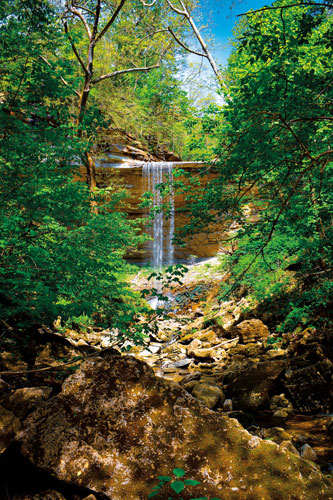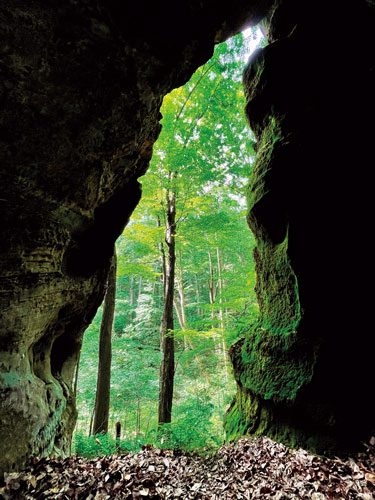About Outdoor Indiana
Outdoor Indiana, the state's premier magazine, delivers the wonders of the Hoosier outdoors to subscribers' homes and offices six times a year in 48 pages of vibrant color. For the best of state parks, lakes, wildlife, forests, trails, hunting, fishing, wildflowers and outdoorsy people, plus inside information from DNR experts, subscribe for $15 per year or $28 for two years. Follow the magazine staff on Facebook.
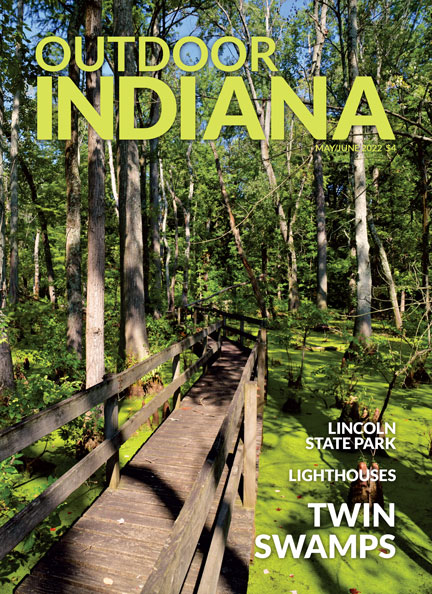
Twin Swamps Nature Preserve in Posey County gives visitors the feeling of being much farther south. Photo by Frank Oliver.
Featured Stories
- From the Director
YOUR INSURANCE AGAINST FLOODS

DNR Director Dan Bortner
Last year, Indiana had 103 flooding or heavy rain events. Despite the severe financial harm flooding hazards present, only 1% of the state’s households are covered by flood insurance.
According to the Federal Emergency Management Agency (FEMA), $282.46 million in FEMA flood insurance claims have been paid in Indiana since 1978. Nationally, almost 40% of flood insurance claims come from low to moderate risk areas or areas outside the mapped flood hazard areas on the Flood Insurance Rate Map (FIRM).
To reduce the number of families financially devastated by flooding, the DNR has partnered with the Indiana Department of Homeland Security, the Indiana Department of Insurance, and FEMA to encourage Hoosiers to purchase flood insurance. More information is at IN.gov/floodinsurance.
To help you better understand the flood risk to your home, the Division of Water developed the Indiana Floodplain Information Portal. This mapping application provides floodplain information from FEMA and DNR sources and allows you to generate a Floodplain Analysis and Regulatory Assessment report. You can also submit a site for review. More information can be found at on.IN.gov/water.
While purchasing flood insurance might seem costly, the National Flood Insurance Program is available to help provide citizens affordable coverage based on the area they live in. This federal program reduces the impact of flooding by providing affordable policies to property owners, renters, and businesses.
- ‘THERE I GREW UP’
Lincoln State Park celebrates president’s Hoosier heritage
By Scott Roberts, OI staff
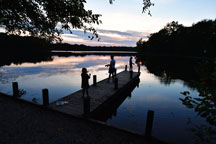
Children fish at Lake Lincoln while staying with their parents at Lincoln State Park’s family cabins. Young Abraham Lincoln lived for 14 years among the area’s woods and waters. (John Maxwell photo)
It’s December 1816. A wagon with all of the Lincoln family’s possessions rolls down a dirt road toward a new home, a wooded area in Perry County in southwest Indiana.
Thomas Lincoln hopes this land will be easier to protect and develop. Much of the Kentucky property he claimed over the past 10 years was pried from him in a series of disputes. The family also chose to move because it disagrees with slavery, which is legal in Kentucky but banned by Indiana’s constitution.
There are enough trees to build a cabin, and the soil seems fertile enough for farming. The Ohio River, a few miles south, provides easy access to markets. Thomas hopes there will be enough food, wood, and merchants to trade with to support his wife Nancy and two children, Sarah, 9, and Abraham, 7.
“We reached our new home about the time the State came into the Union,” the son would write in his second autobiography. “It was a wild region, with many bears and other wild animals in the woods. There I grew up.”
The Lincolns spent the next 14 years on that plot of land. They experienced triumphs, like expanding their property by 20 acres and turning it into a working farm that would supply their needs. There was also tragedy. Nancy Hanks Lincoln died in 1818 of milk sickness, which is caused by drinking contaminated milk from cows that fed on white snakeroot. Nearly 10 years later, Sarah Lincoln Grigsby died in childbirth.
Abraham Lincoln and a few members of his family moved to Illinois in 1830.His legacy is celebrated today on the grounds he trod almost 200 years ago, which is now Lincoln State Park and the Lincoln Boyhood National Memorial.
- GUIDING LIGHTS
Indiana’s lighthouses serve historic, symbolic purpose
By Scott Roberts, OI staff
Photography by Frank Oliver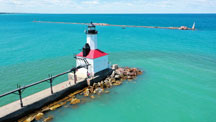
The Michigan City Pierhead Light and Michigan City Breakwater Light have lit the city’s harbor for more than 100 years.
A piercing white beam can be seen from Michigan City’s East Pierhead Light at Washington Park each night.
On stormy evenings, its foghorn can be heard, two blasts every 30 seconds. The sound is called the light’s characteristic, or how it’s distinguished from other lights.
The light’s purpose is now mostly symbolic. It was deemed excess by the U.S. Coast Guard in 2007 and is now maintained by Michigan City as a tourist destination and a symbol for the region. It’s photographed several times a day and thousands of times a year. Its image appears on marketing materials for the city, from brochures to websites to trinkets available in shops along the shore.
That flashing light also serves as a beacon to the past, to a time when ships needed that beam and foghorn blast to guide them into the city’s harbor, one of the first on southern Lake Michigan. The pierhead light was built in late 1904 at the end of a newly constructed quarter-mile-long breakwater. The shipping industry on the Great Lakes was just beginning, and by 1910, the amount of goods it transported reached 80 million tons.
In 1911, the Pierhead Light received illumination help from the Michigan City Breakwater Light, a 23-foot-tall white tower with a flashing red light located on the other side of the breakwater.
Both lights replaced the Old Michigan City Lighthouse. It was built in 1858 and is now a museum showcasing the navigational history of the city. It’s the only true lighthouse in Indiana, because it’s the only one still standing that keepers once lived in and maintained. Those are usually the only light structures that can technically be called lighthouses, even though common usage has morphed to mean almost any structure on the water with a light in it.
While the harbor lights at Michigan City were the first in Indiana, they were joined by others along Indiana’s 45 miles of shoreline. Remnants of the Indiana Harbor Light in East Chicago and the Calumet Harbor Lighthouse in Hammond still stand, along with the Buffington Harbor Breakwater and Gary Breakwater lights, both in Gary.
The three Michigan City lights are on the National Register of Historic Places. Paul Diebold, an architectural historian with DNR Division of Historic Preservation & Archaeology, said lighthouses helped bring the industrial era to Indiana and helped the state modernize.
“Railroads and ships were moving things inside the country way more than people now realize, and that started with ports and lighthouses to guide these ships into them,” he said.
Lighthouses also tell us about ourselves. Many people see their lives and struggles through the historic structures’ constant vigils, which may be one reason so many still take pictures of them.
- SOUTHERN ACCENT
Experience Twin Swamps’ unique environment
By Scott Roberts, OI staff
Photography by Frank Oliver
The Michigan City Pierhead Light and Michigan City Breakwater Light have lit the city’s harbor for more than 100 years.
Cypress knees and long, exposed roots are two of the hallmarks of bald cypress swamps. Scientists are not sure what function the knees play in the tree species’ development.
The small gravel parking lot belies the wonders you will find at Twin Swamps Nature Preserve as you step on its narrow dirt trail and start to explore.
Carrie Parmenter of North Vernon figures she and her family have made the hike a dozen times in the past 10 years, and she says each trip reveals something they hadn’t seen before. The half-hour drive from their home is filled with anticipation as to what comes next.
“It’s a completely unspoiled landscape that’s truly unique in Indiana,” Parmenter said. “We always see interesting wetland species of birds, animals, and plants you don’t see often, and it’s especially beautiful when the spring ephemerals are blooming.”
Numbers verify Parmenter’s impressions. The preserve is home to 39 state endangered, state rare, or state threatened species according to the DNR Division of Nature Preserves. It is one of five Indiana sites to be named a Wetland of Distinction by the Society of Wetland Scientists and one of about 40 nationwide.
Reader Photos
Each issue, Outdoor Indiana staff will select reader submitted photos to feature in the magazine. If you would like the chance to be featured, please submit your photo, along with your name and phone number to:
Please, only submit original photography that you have taken. Do not send files over 9 MB in size. JPG format is preferred.
Subscribe to Outdoor Indiana magazine
Visit the Indiana State Parks online store to subscribe. Cost is $15 for a one year subscription (6 issues) or $28 for two years (12 issues).
Donate
Printing and distribution costs for Outdoor Indiana magazine have increased. One way we’re offsetting these costs is through the Friends of Outdoor Indiana Group administered through the Indiana Natural Resources Foundation. Donations to our friends group helps keep our subscription price low and ensures we’ll be around to bring you the best of Indiana’s outdoors for years to come. Donate at the INRF website and include “Friends of Outdoor Indiana” in the “In Honor Of/In Memory Of” line.
Outdoor Indiana
402 W. Washington St., W255-B
Indianapolis, IN 46204
317-233-3046
OIorders@dnr.IN.gov

